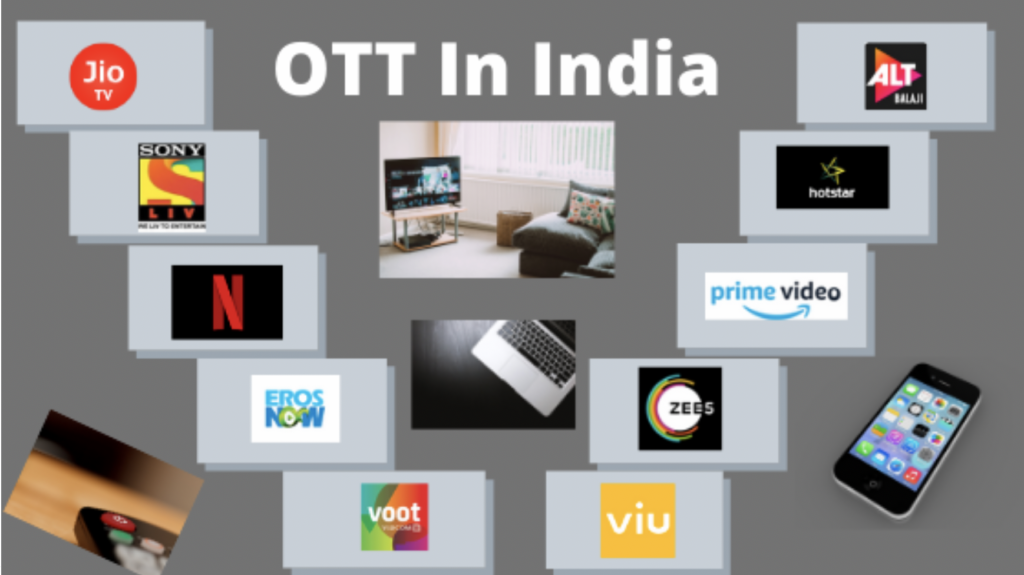THE OTT SCENARIO IN INDIA
Since the launch of India’s first OTT platform BIGFIX in 2008, the OTT market in India has been continuously evolving. There are now about 40 OTT players in the market, ranging from global OTT platforms Netflix and Amazon Prime Video to local Indian platforms like Balaji ALT, Sony’s Liv, MX Player of Times group, Zee 5, Eros Now and Viacom 18 Voot.
The OTT market in India is at a very competitive stage. Various platforms are focusing on price innovation, content creation, partnerships and mergers and acquisition as strategies for growth. Alt Balaji and Zee 5 have recently announced that they will co-create content for 60 original Hindi series, which will be streamed on both platforms.
COMPETITION AMONG OTT PLAYERS
Hotstar is the leader in the entertainment segment with 49% app installations. The main factor behind its popularity is its focus on sporting events, especially cricket events like IPL and Cricket World Cup. Cricket is not only a national sport, but it is more like a religion in India. And Hotstar has tapped that potential.
Alt Balaji has a strong customer base as it has low prices and is attracting viewers outside big cities. A 12-month Alt package costs just $4.25. Compare this with Hotstar and Amazon, for which one has to pay $14, and when it comes to Netflix, the cheapest plan available is $2.88 per month.
Amazon Prime Videos added a Hindi User Interface in November 2018. Viewers can manage their accounts, payments and receive customer support – everything in Hindi. Amazon had previously introduced content in five Indian regional languages besides Hindi. Amazon offers monthly memberships for $1.80 per month or annual memberships at $13.91.
Apple TV Plus launched its subscription at Rs. 99 ($1.38) per month from Nov 1. It can be accessed on all Apple devices and smart TVs. It also provides family sharing access to six individuals.
The phone companies are not far behind. Airtel launched its app V-Fiber. If you subscribe to V-Fiber, you get Netflix free for three months and free access to Amazon Prime Videos for one full year.
Netflix has high prices and few offerings in local languages. To reach a larger audience, Netflix plans to extend the number of languages in which content is available. The annual Netflix subscription is fifteen times costlier than Hotstar. To counter that, Netflix announced 199 INR ($2.77) mobile-only plan, but with no HD viewing.
The entertainment landscape in India has changed so much that the first experience with the internet for domestic helpers and chai walas is on their phones. Low costs for mobile data and more affordable smart phones have revolutionized overall video content competition. People want to see more and more content streaming in their own language, and this is what increased the demand for subtitling.
STATISTICS AND PROJECTIONS
According to a recent KPMG Eros report, nearly 87% of daily online video content is viewed through mobile phones in India. On the other hand, a recent Broadcast Audience Research Council’s Broadcast India Survey shows that the number of TV-owning households increased to 197 million and number of viewers rose by 7 % in 2018. In comparison, Hotstar has a little over 60 million viewers. Not to forget that it was Hotstar that set a global streaming record during ICC Cricket World Cup semi-final game by registering 25.3 million viewers during the game.
India has the second highest per capita consumption of online videos in the world, next to Philippines. Indians spend 30% of their time watching media and entertainment when they are on mobile devices. It is the second most popular activity with smartphone users in India. India has a higher percent of mobile streaming compared to the US.
According to the Counterpoint Research’s India OTT Video Content Market Consumer Survey, Indians under the age of 35 account for 89% of total Indian OTT video content platform users. Of the total number of OTT users, male population is 79%. Mobile viewing is so popular among men because prime time TV does not cater to the interests of the male population except for news and sports. Prime time TV is mainly focused on the saas-bahu (mother-in-law and daughter-in-law) sagas, women-oriented shows and programs.
With so many players in the game, it should not come as a surprise to see the players that are here today might be gone tomorrow. Ultimately, only the top few will survive. PWC Report has projected that Indian OTT market will grow at 22.6% annually, which is double the global rate of growth.
BENEFITS OF OTT
These OTT platforms are offering ad-free content, and premium and uncensored content, while spending from their profits to ensure no piracy. Besides, watching Bollywood movies on these platforms comes out as much cheaper than going to a multiplex to view a movie. And nothing can beat the luxury of enjoying a movie with your loved ones, from the comfort of your couch with hot tea and samosas.
SUBTITLING ECONOMY IS RISING
Earlier, subtitles were needed only for movies that were released overseas or if they were selected to be shown at film festivals. But the subtitling industry has received a boost since OTT platforms like Netflix and Amazon have come to India. These platforms aimed to expand the viewer base for their existing content library, which was mainly in English, so subtitling was the direction to follow because dubbing was ten times costlier.
In order to reach a wider audience, the OTT players are focusing on content creation in local languages. As a result, demand for localization and differentiated content is rising. Thus, these content streaming platforms have created an economy around subtitles in India.
This first blog on the evolving OTT market in India shows how the growth and affordability of mobile has contributed to the rise of OTT streaming services in India. In our next blog, we will examine the problems faced by subtitlers due to this growing demand for content localization. Our third blog will examine subtitling and OTT challenges faced by vendors and subtitlers in India.


2 thoughts on “The Evolving OTT Market in India”
Comments are closed.